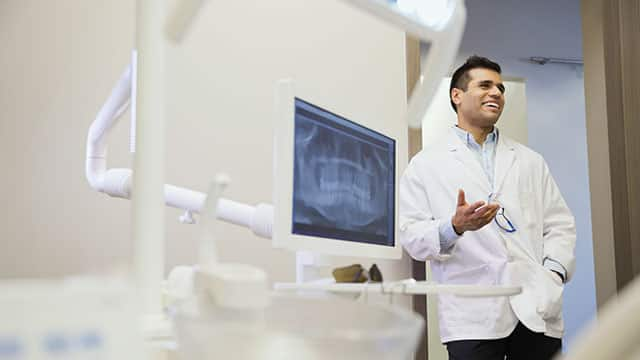What Is an Apicoectomy?
The first step to understand an apicoectomy is to gain some knowledge of the anatomy of your teeth.
The inside of your tooth is filled with soft tissue called the pulp, including blood vessels and nerves. These run from inside the top (also called the crown) of your tooth down through its root, where they connect with your circulatory and nervous systems.
The tissue around the tip of your root can become infected or reinfected, even after prior treatment. Your dental professional may recommend an apicoectomy (also called a reverse root canal) to remove the infected tissue. According to the American Association of Endodontists, they may place a cap to seal the end of your root.
Your dental professional will likely only recommend an apicoectomy after one or multiple root canals or when other circumstances (like having a bridge) prevent root canal treatment. Root canals may be unsuccessful in removing all your infected tissue, causing reinfection or preventing healing.
Helpful tip: Your teeth typically have between 1-3 roots (varying on the type of tooth), and each can have multiple root canals, according to the National Health Service.
Preparation
Before your apicoectomy procedure, you may receive:
- A consultation with your dental professional regarding your condition
- X-rays of your affected tooth and surrounding bone
- Pre-procedure care recommendations, including antimicrobial mouthrinse, medicine to reduce inflammation, or antibiotics
- A review of your medical history, including your past and current medical problems and a list of medications
How It's Done
If you’re stressed about an upcoming apicoectomy, rest easy knowing that they’re performed by highly trained dental professionals with your best interests in mind. Typically, your procedure will be done by a general dentist with advanced training, endodontist, or oral or maxillofacial surgeon.
An apicoectomy may include your dental professional:
- Injecting local anesthetic to numb the area around your infected tissue
- Opening gum tissue around your affected tooth
- Removing inflamed or infected tissue along with the tip of your root
- Sealing the end of your root with a filling
- Applying a few stitches or sutures to aid your healing
Your dental professional may take an x-ray during the apicoectomy before closing your gums to ensure accuracy. The length of the procedure will vary based on the tooth's location, the complexity of the root structure, and your individual needs.
Follow-Up
You’re likely to experience some pain or discomfort following an apicoectomy, as you will have infected tissue removed and be injected with anesthetics. Avoid eating while you’re still experiencing any numbness to avoid harming your mouth or stitches.
As your apicoectomy removes infected tissue, you could feel better than you did quickly after the surgery!
But what’s the normal recovery time? According to the American Association of Endodontists, pain after surgery is generally low, and many return to their normal routines the day after surgery. However, it can take several months for the bone to heal around the root fully.
Steps you can take after your apicoectomy:
- Practice your dental routine especially gently as not to aggravate sensitive areas
- Avoid smoking, crunchy foods, or damaging any stitches
- Take medications as prescribed and follow provided aftercare instructions
- Use over-the-counter pain relievers or anti-inflammatories to help with discomfort or swelling
- Follow up with your dental professional if your stitches require removal (many dissolve on their own!)
- Apply a cold compress or ice pack to the affected area for twenty minutes on, twenty minutes off (according to the Cleveland Clinic)
Though dental procedures can be challenging, many find their apicoectomy to require less recovery than a root canal treatment.
Important note: Contact your dental professional if you’re experiencing unusual or extreme symptoms. Be on the lookout for abnormal pain, swelling, numbness, or find signs of infection (like discharge draining into your mouth). When in doubt, it's best to reach out for professional advice.
Apicoectomy Risks
Every dental procedure generally has a risk of complications or failure, but your dental professional will not recommend an apicoectomy unless they believe it has a high chance of success. If the procedure is successful, it should be effective permanently with the life of your tooth. If it is not successful, they may have to perform an additional procedure or extract your tooth.
Your dental professional may recommend antibiotics to help prevent the spread of infection after your apicoectomy (but you shouldn't take antibiotics without a prescription). Surgery near the tip of your root may carry a small risk of nerve damage.
When considering an apicoectomy, the only other choice is typically the removal of the tooth. Many prefer to keep their natural tooth because removing and replacing them may be more complicated and expensive than an apicoectomy.
Apicoectomies are common procedures that could be the perfect choice to save your natural tooth from infection or removal. Even though it can be difficult to commit to a dental procedure, you’ll be glad to have made a positive choice for your long-term oral health.
Oral Care Center articles are reviewed by an oral health medical professional. This information is for educational purposes only. This content is not intended to be a substitute for professional medical advice, diagnosis or treatment. Always seek the advice of your dentist, physician or other qualified healthcare provider.
ORAL HEALTH QUIZ
What's behind your smile?
Take our Oral Health assessment to get the most from your oral care routine
ORAL HEALTH QUIZ
What's behind your smile?
Take our Oral Health assessment to get the most from your oral care routine















